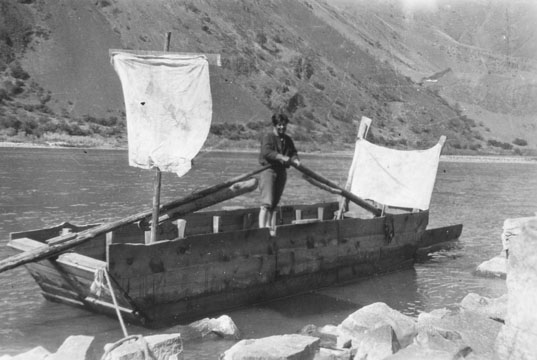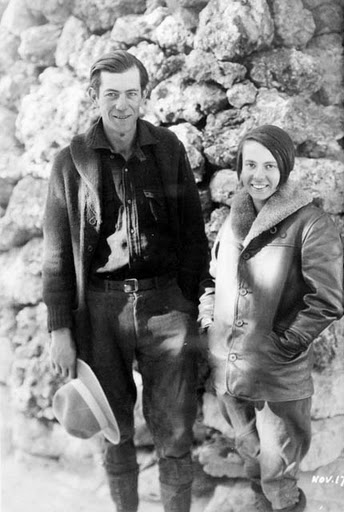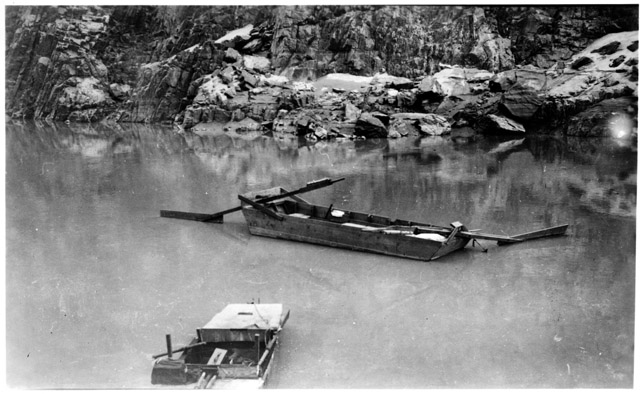The early days of Grand Canyon river running are riddled with disaster, by 1928 only forty-five people had managed to fully traverse the entire length of the Grand Canyon by boat. This group, comprised solely of men, accomplished their feats using traditional and modified rowboats. In 1928, newlyweds Glen and Bessie Hyde wanted to make their mark on Grand Canyon history by taking a different kind of boat, the sweep scow, down the river. What ensued in the fall and winter of 1928 became one of the biggest unsolved mysteries in Grand Canyon to this day. The “Honeymoon Couple,” as they came to be known, mysteriously disappeared on their journey in the canyon, no bodies ever surfaced, and nobody knows what happened. This gripping tale is best told by author Brad Dimock in his book, Sunk Without a Sound: The Tragic Colorado River Honeymoon of Glen and Bessie Hyde. His research is exhaustive, and it is the definitive work on the subject.
Glen Rollin Hyde was born on December 9, 1898 to Rollin and Mary Hyde. His younger sister Jeanne Hyde said that Glen got his start boating in Prince Rupert, British Columbia while taking family canoe trips on the Skeena River. In 1919 Glen launched a grand expedition with friend, Jess Nebeker. They spent six months canoeing, fishing, and hunting down the Peace River in Canada. Three years later in Moscow, Idaho, Glen met boatman Harry Guleke. Glen listened intently to his stories at the helm of a giant wooden boat called a sweep scow. From these stories Glen conceived his own plan to make a scow and take it from the Salmon River all the way to the Pacific Ocean, but school prevented the journey until 1926; at which time he completed the trip with his little sister, Jeanne.
Bessie Hyde, born to William and Charlotte Haley on December 29, 1905, always had a knack for theater. In high school she played the part of Juliet in the school’s rendition of Romeo & Juliet. She graduated in 1924 and moved alone to California. She enrolled at the California School of Fine Art in San Francisco. There she wrote an unpublished volume of poems titled “Wandering Leaves.” In February of 1927 she met Glen Hyde on a boat trip to Los Angeles. The two instantly hit it off and married April 12, 1928 in Twin Falls, Idaho.
The year prior to the wedding a couple of filming expeditions launched down the Grand Canyon. One of them required a search and rescue that garnered the party and the river national attention. With Glen’s boating experience and Bessie’s craving for renown they hatched a plan to do the same. The first woman down the Colorado River was sure to bring book deals, lecture circuits, and possibly even a vaudeville play. It took Glen only two days and fifty dollars to build his wooden scow. They loaded it with supplies, journals, and even a bedspring; after all it was their honeymoon. They pushed off in late October from Green River, Utah. One thing Glen did neglect to bring: life-jackets.
Riding in the aptly named “Rain-in-the-Face”, the couple made it through Labyrinth, Stillwater, and Cataract Canyons unscathed. In Grand Canyon they landed at Bright Angel Creek to climb the South Kaibab Trail. On the rim they met the famed boatman, Emery Kolb. He showed them around the rim and offered to supply Glen with some life-jackets, but Glen refused. When asked later Emery said Bessie seemed ready to quit right then and there, but Glen persisted and they proceeded down the trail the next day. Down at the river they met Adolf Sutro, grandson of the famous Adolf Sutro. Sutro found himself interested by their boat, and proposed to ride along with the Hydes for a day and hike out at Hermit Trail. Glen accepted and toted Sutro the eight miles to Hermit Creek. There Sutro disembarked. He was the last person to see them alive.
The couple planned to arrive in Needles, California on December 9th; when no word came through, Rollin, Glen’s father, immediately hopped a train for Las Vegas suspecting something was wrong.
He searched high and wide for his missing son and daughter-in-law. He had multiple river parties launched in a matter of days, he hired Native American trackers to search the rim; he even got Secretary of War, Dwight Davis, to authorize an aerial search of the canyon. On December 19th the search paid off. The military planes spotted the scow snagged mid-river at river mile 237. The pilots reported the boat looked relatively undisturbed, and it brought renewed hope to Rollin.
He immediately headed to Peach Springs, Arizona with the Kolb brothers. They planned to hike down Peach Spring Wash and salvage a boat waiting at the mouth of Diamond Creek, river mile 225. It took an agonizingly slow three days for the brothers to fix the boat, and launched on the morning of December 24th. On Christmas morning the party found the scow floating eerily in a calm pool above mile 237. The brothers, photographers by trade, filmed the scene. On the boat they found everything in place; books, diaries, food, clothing, and gun were all there, but there was no trace of the Hydes. The party took all they could and cut the boat loose, when they reported back to Rollin they told him the couple had definitely not left the scow intentionally.
By the turn of the New Year the newspapers conceded the death of the Hyde’s and moved on to other news. The crestfallen father stumbled back to Idaho to ponder over Bessie’s journal.
He came back the next winter to search the rim country for their bodies, but he never found them. After a time conspiracy theories abounded. Bessie’s father leaned toward murder. Famed river runner Norman Nevills believed drowning was the best answer. River historian Otis Marston believed the couple crashed in a violent rapid at mile 232. In the years since more than one person has claimed to be Bessie, but until their bodies are found we will never know for sure. Perhaps the story is best left with this eerie poem:
Oh! Mamma dear, please come!
My dolly must be drowned,
When I put her on the creek,
She sunk without a sound.
Wee Betty’s eyes filled with tears,
Where could poor dolly be?
Perhaps she’d turned into a mermaid,
And drifted out to sea.
-Bessie Haley Hyde-
Written By Mark Buchanan
References:
- Abacus, C.V. “Dock’s Data of Navigational Numbers: The First 100 Grand Canyon River Runners.” boatman’s quarterly review 22, no.3 (2009): 21-25.
- Dimock, Brad. Sunk Without a Sound: The Tragic Colorado River Honeymoon of Glen and Bessie Hyde. Flagstaff, Arizona: Fretwater Press, 2001.





